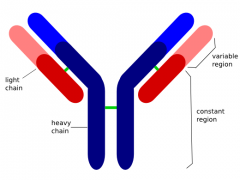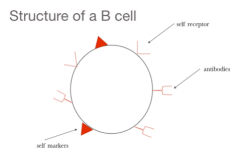![]()
![]()
![]()
Use LEFT and RIGHT arrow keys to navigate between flashcards;
Use UP and DOWN arrow keys to flip the card;
H to show hint;
A reads text to speech;
23 Cards in this Set
- Front
- Back
|
lymphocytes |
cells found in the lymphatic system |
|
|
B cells |
- mature in bone marrow - plasma cels which make antibodies presented on surface - each has 1 particular antibody |
|
|
T cells |
- mature in thymus - t-helper cells - cytotoxic T-cells - t-lymphocytes - target pathogens directly |
|
|
lymphatic system |
network of vessels that transport excess tissue fluid back into circulatory fluid |
|
|
lymph node |
oval or bean shaped structure scattered throughout body, filter lymph by trapping foreign particles which are then destroyed |
|
|
humoral immunity |
- B cells in action
- millions of different B cella with different antibodies on their cell membranes which identify and bind with specific antigens |
|
|
clonal selection |
1. antigen enters body 2. passes different B-cells until it meets with antibody that matches 3. antigen 'selects' B cell 4. B cell divides rapidly to produce plasma cells and memory cells |
|
|
Plasma Cells |
secrete antibodies against specific antigens and has a lifespan of only a few days, but can produce about 2000 antibody molecules per second |
|
|
Memory Cell |
- long lived and reside in lymph nodes - when these cells encounter the same antigen again, they rapidly differentiate into antibody producing plasma cells |
|
|
antibodies |
- made from protein molecules - 4 polypeptide chains -2 light, 2 heavy |
|
|
antibody structure |

|
|
|
antibody - antigen response |
antibodies bind to antigens and clump together in a process called agglutination |
|
|
agglutination |
1. prevents the pathogen from harming body cells 2. assists in phagocytosis 3. can neutralise toxins |
|
|
humeral response |
an antibody on the surface f B cells identifies antigen with a complementary structure. This identification stage can take a number of days. once a B cell recognises the antibody it reproduces into a large number of plasma cells and memory cells |
|
|
structure of a B cell |

|
|
|
steps of humeral response |
1. antigen floats around 2. antibody on B lymphocyte binds to floating antigen 3. b cell recognises that antigen and antibody have bound together 4. clonal selection, divides into plasma or memory cell 5. plasma cell creates more antibodies to clump together and prevent antigens from infecting the body 6. memory cell memorises antigen for future exposure |
|
|
Cell Mediated Response |
- requires T lymphocytes |
|
|
T cells |
- t cells originate in bone marrow but mature in thymus gland - antibody like receptors called T cell receptors - unique and specific for particular antigens |
|
|
3 types of T cells |
1. cytotoxic t cells 2. helper t cells 3. suppressor t cells |
|
|
cytotoxic T cells |
- binds to infected cell and clones into Tc cells and T memory cells - releases perforin which punches holes in the infected cells membrane and enzyme enters - infected cell is destoryed |
|
|
Helper T cells (Th) |
when Th cells recognise and bind to specific antigens on cell surfaces, they release cytokines called interleukins which activate Tc cells and B cells and causes them to divide |
|
|
Suppressor T cells |
- regulate action of T and B cells
- capable of suppressing action of phagocytes - help prevent the immune system overreacting to a stimulus |
|
|
T cell activation |
T cells are activate by antigens that are processed and presented bound to MHC markers by infected cells or macrophages |

